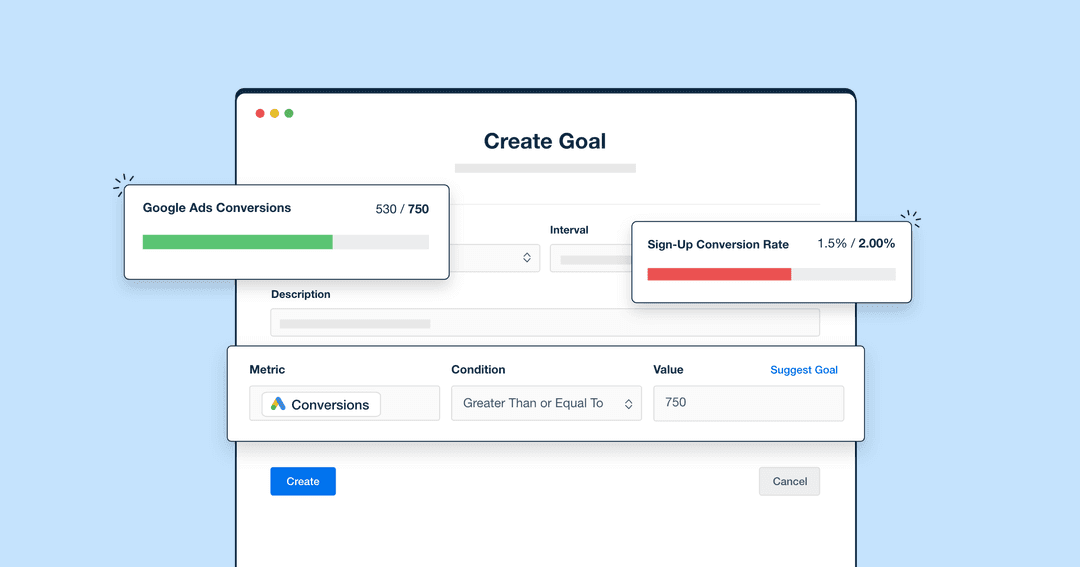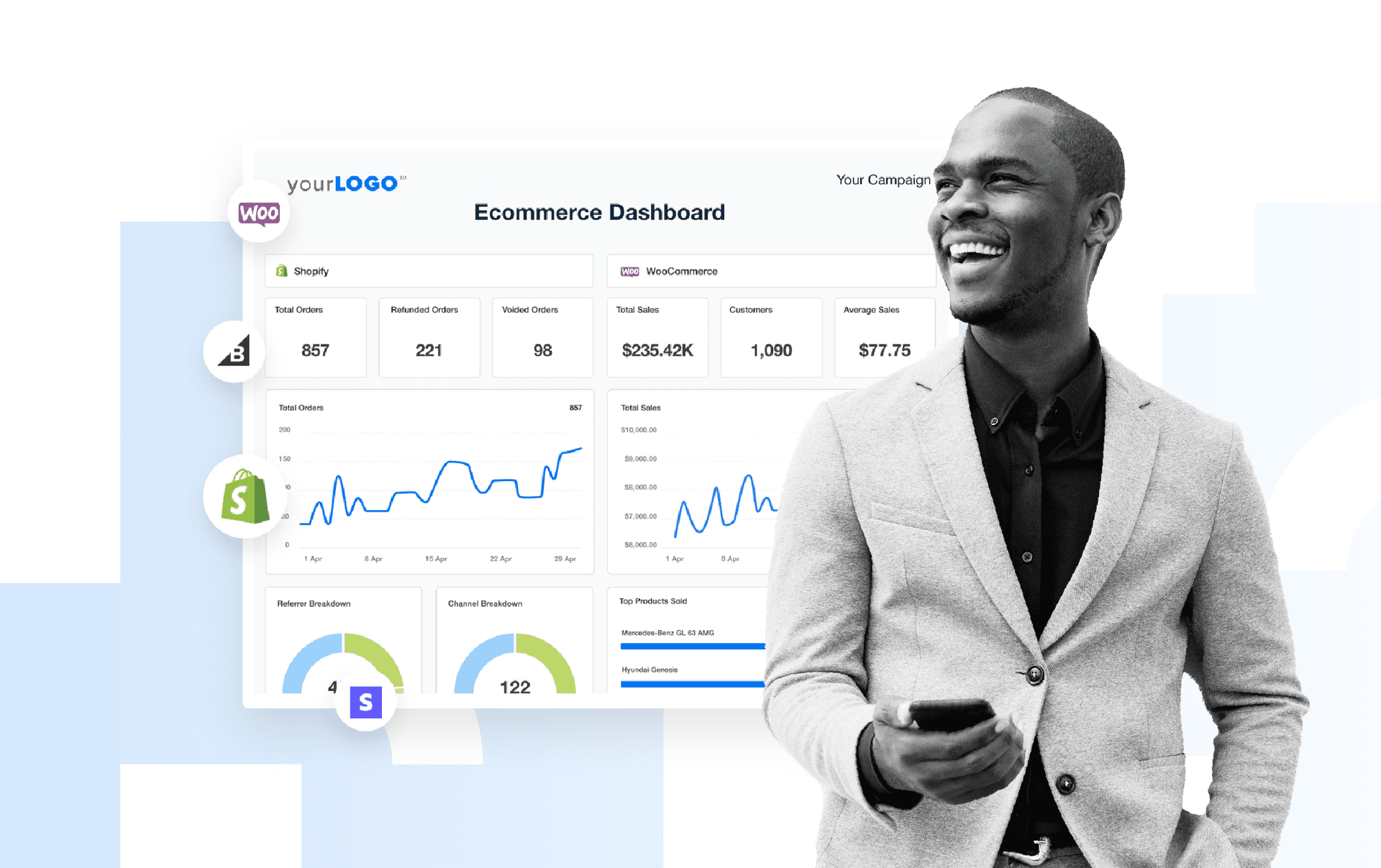Table of Contents
QUICK SUMMARY:
Goal-based reporting is a streamlined approach that emphasizes key achievements instead of overwhelming details, offering a clear snapshot of campaign performance. It simplifies data into digestible insights that align with client objectives by prioritizing top-level metrics. This articles shares how reporting goals help agencies demonstrate progress, strengthen client relationships, and showcase the value of marketing efforts through focused metrics and narratives.
At a digital marketing agency, conveying campaign results to clients is often a daunting task. Compiling data from multiple sources takes time and effort, and many clients are only interested in the highlights rather than the intricate details. This is where goal-based reporting comes into play.
Imagine a world where sharing marketing campaign results with your clients doesn't have to resemble a game of 20 questions. Picture a reality where you can spotlight the top-line results automatically, and your clients are informed and happy. This is the world of goal-based reporting, where goals and metrics work together perfectly.
I believe reporting & attribution to be one of the key factors in client retention. As a performance-driven agency, we work to ensure we're achieving our client's goals, so a quick review & summary goes a long way for our clients.
Christopher Marrano, Founder/CEO, Blue Water Marketing
Goal-based reporting is an approach that focuses on key achievements rather than getting lost in overwhelming details. It provides a clear, concise picture of the campaign's performance, showcasing only the most crucial metrics. It's not about cutting corners but delivering the essential insights that make a real difference for your clients.
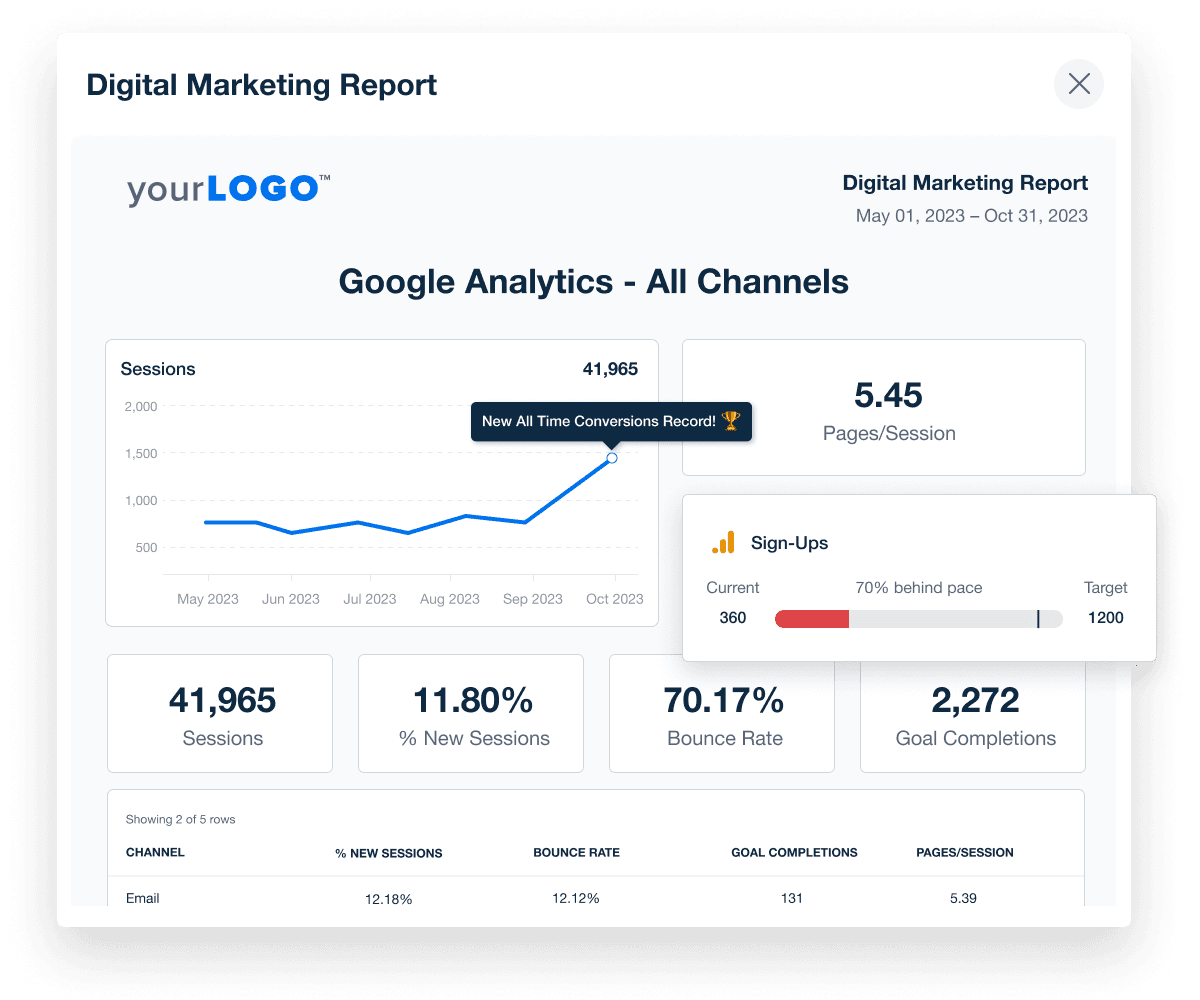
With goal reports, you quickly transform a mountain of data into meaningful, easily digestible insights. You highlight the top-level achievements that matter most to your clients, not just a flood of statistics. It’s like translating the complex language of data into a dialect your clients understand and appreciate.
So why goal reports? Because they are a lifesaver when it comes to simplifying the complex. These reports strip away the layers, revealing only the top-level insights that are meaningful to your clients.
Our clients care about their budget and how many phone call leads they can get from it. All other metrics are tossed aside.
Rebecca Pena, Marketing Director, Investigator Marketing
Prepare to dive into goal-based reporting, where simplicity meets effectiveness. It's an innovative way to deliver key metrics, fostering a better understanding of campaign results. This guide will help you navigate this approach, ensuring your reporting aligns with your client's goals and interests.
The Art of Goal-Based Reporting
Goal-based reporting is more than a novel method of conveying performance data. It's an art that leverages the science of numbers and analytics to create a narrative around success and progress.
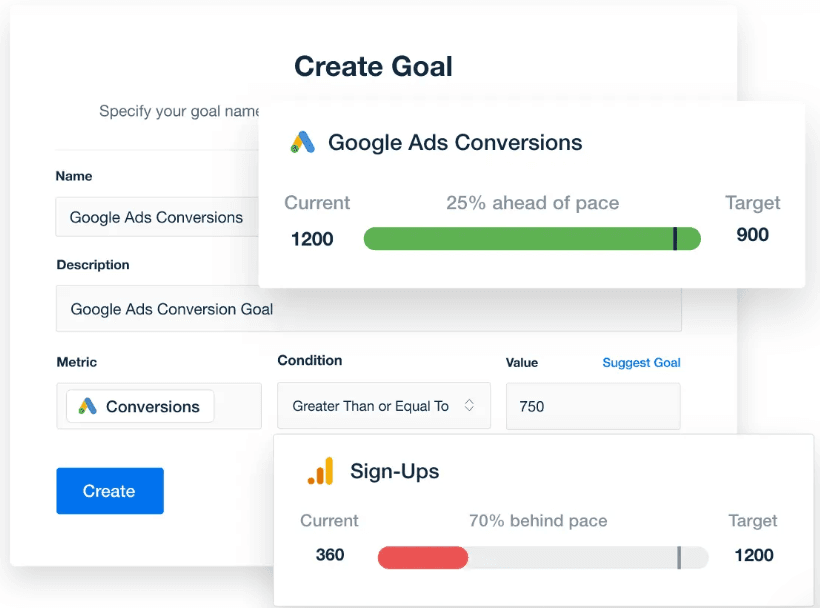
This narrative is tailored to be client-centric, focusing on what matters most to the businesses you serve. Let's dive into the artistry involved in goal-based reporting.
Understanding the Purpose of Goal Reports
At their core, goal reports serve as a bridge, connecting the gap between what an agency does and how it impacts the client's bottom line. The key is to transform that vast ocean of data into a streamlined river that leads directly to the client's business goals.
Report on what’s necessary rather than everything and anything to make your reports more meaningful. I always look at data and ask myself SO WHAT? Build out templates that focus on the metrics each client needs to see. If the report doesn’t answer The SO WHAT question then don’t send it.
Cheryl Ingram - Managing Director, TDMC
Goal-based reports are an essential tool in building and strengthening client relationships. They provide a simplified view of how tasks and efforts contribute to individual goals and overall business objectives. It's a way to say, "Look, here's the progress we're making together!" clearly and concisely.
The Value of Prioritizing Top Metrics
Every business has a specific goal, or a set of goals, driving their actions. By aligning reporting with these goal sets, agencies can demonstrate how their work contributes to these targets.
Every client has unique challenges and goals, so it's crucial to take the time to tailor your reports to their specific needs. By doing so, you'll be able to provide valuable insights that speak directly to their business objectives, and ultimately help build stronger relationships with your clients.
Adam Binder, Founder + CEO, Creative Click Media
This focus ensures that clients stay aware of the minutiae of data and, instead, see the bigger picture - the impact of the agency's efforts on their business goals.

Prioritizing top metrics in your reports helps maintain the focus on what’s genuinely crucial for the business. This strategy eliminates noise, highlights achievements, and makes the reports digestible, relatable, and, most importantly, relevant.
Using KPIs vs. Metrics in Goal-Based Reports
While KPIs and metrics are integral parts of any goal-based report, understanding their difference can make your reports even more impactful.
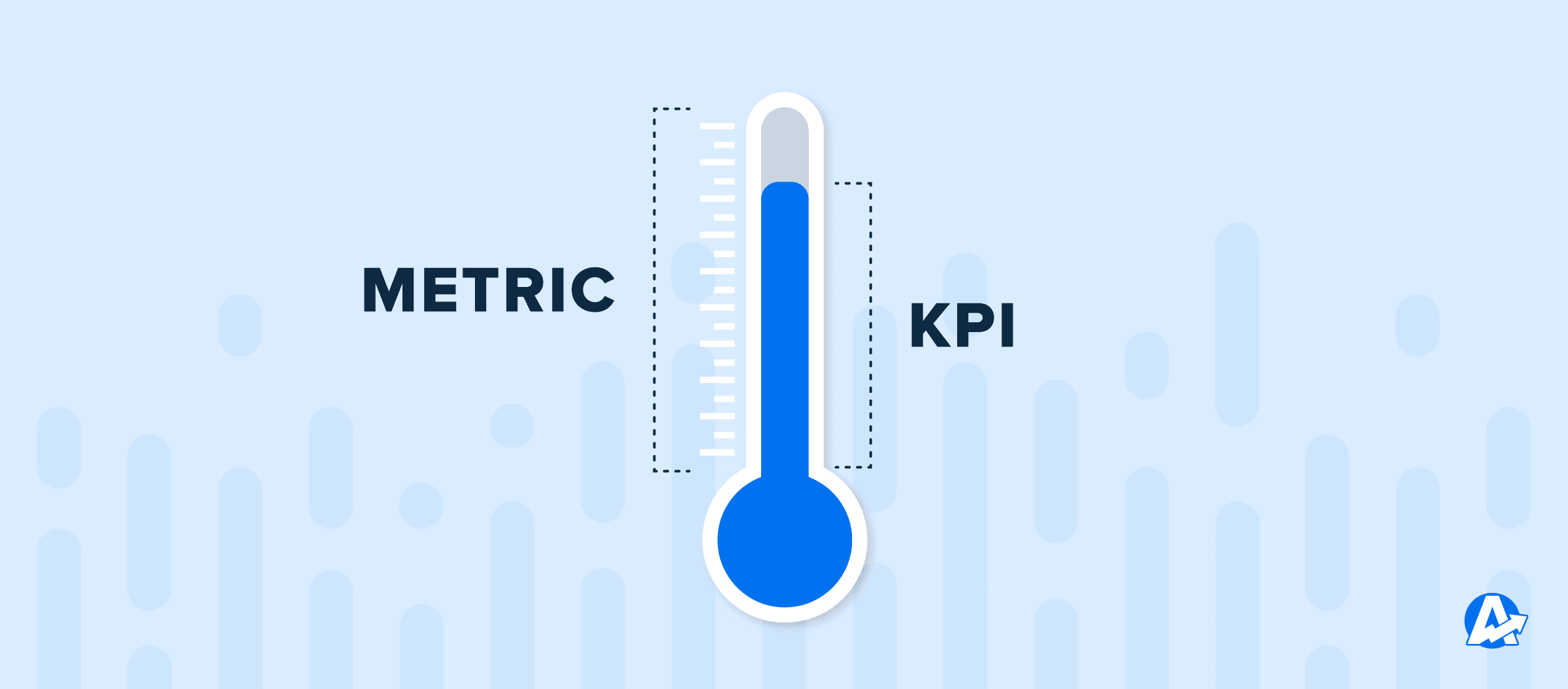
Metrics provide a quantitative measure of data or progress in certain areas. They are the individual threads that, when woven together, create the fabric of the report.
KPIs, on the other hand, are more strategic. They are the metrics that align directly with the business objectives, acting as guiding stars leading the way to achieving specific goals.
Professional reports help communicate the results of marketing campaigns, website performance, and other key metrics to stakeholders such as clients, management, and investors. This helps demonstrate the value of the work being done and provides a clear picture of progress towards goals and objectives.
Daniel Dye, President, Native Rank, Inc.
By incorporating KPIs and metrics into your goal-based reports, you present a snapshot of the current state and projecting an insightful narrative of the journey toward the objectives. This detailed picture directs the tasks and efforts, adding another layer of depth to your reporting.
Embracing the art of goal-based reporting is about creating reports that are more than just a collection of numbers and statistics. It's about crafting a story of progress that speaks directly to the heart of your clients' business goals.
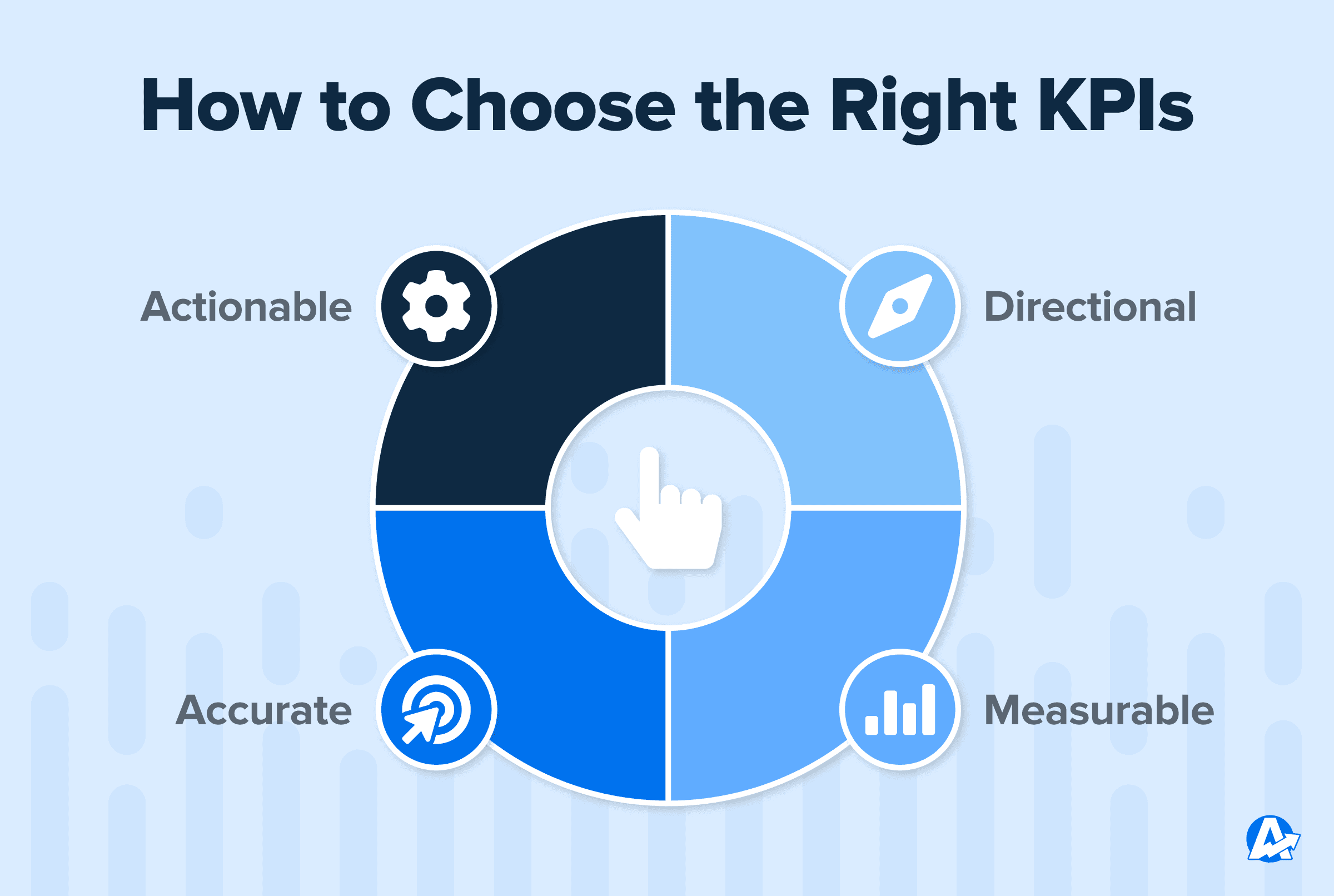
Choosing the right Key Performance Indicators (KPIs) for your clients is pivotal in generating custom reports that are both meaningful and effective. Each KPI you select should meet the following criteria to ensure the success of the goal-based reporting approach:
Actionable: The chosen KPIs should be actionable, giving your client valuable insights for informed decision-making. Each individual goal might require different actions, and the KPIs should reflect this by providing data that unlocks potential strategic steps toward achieving these goals.
Directional: Your KPIs must offer directional insights, showing whether the business is moving forward, backward, or staying in place. These indicators guide your clients in their journey, revealing when course corrections may be needed to accomplish their business objectives.
Accurate: Accuracy is paramount in KPIs. They should provide an authentic reflection of the business's realities, mitigating any chances of misinterpretation. Accurate KPIs ensure stakeholders receive a clear and genuine picture of their business performance.
Measurable: Finally, for a KPI to be truly valuable, it must be measurable consistently and reliably. Measurable KPIs allow for tracking progress over time, assessing the impact of various strategies, and making meaningful comparisons. This facilitates the successful tracking of custom goals and overall business growth.
The Mechanics of Goal-Based Reporting
Let's decode the step-by-step process of goal-based KPI reporting - a systematic approach to translating agency efforts into measurable client success.
Step 1 - Identifying Client Goals
The foundation of effective reporting is a deep understanding of the client's existing goals. This step involves clear communication with the client, using during the client onboarding process.
Nothing we do is cookie-cutter; each client has its own unique set of challenges, budget limitations, etc., and so each strategy is tailored to meet the client's goals in the most efficient way possible.
Molly Lopez, Founder & CEO, Sparo
Every individual goal and its place within the broader goal set must be fully understood. This clarity is critical to keeping the team focused on targeted achievements.
Step 2 - Selecting Relevant Metrics
Once goals are defined, the next step is selecting metrics that offer meaningful insights into progress.
During the sales process, we ask the client what KPIs they want to track, often they're unsure and so we make recommendations based on their overall goals.
Paul Morris, Managing Director, Superb Digital
The choice of metrics directly depends on the goals. For instance, metrics like keyword rankings, bounce rate, and average session duration are fitting if the objective is boosting organic conversions.
Creating a Goal-Based Report
Armed with well-defined goals and relevant metrics, it's time to craft a goal-based report. The process involves creating individual goal reports for each client–or at the agency level–ensuring accurate tracking of the selected metrics.
At our agency, we believe that metrics are only useful if they help to drive decision-making. As a result, we focus on identifying actionable metrics that can be used to inform and improve our marketing efforts. To do this, we start by taking a close look at our goals and objectives. We then identify the key performance indicators (KPIs) that will help us measure progress towards those goals.
Guy Hudson, Founder, Bespoke Marketing Plans
With the AgencyAnalytics goals widget, turn each goal into a dynamically updated and visually appealing report widget showcasing how your marketing efforts come together to help your clients succeed.
Before we used AgencyAnalytics, we were spending a lot of time manually creating and updating customized spreadsheet reports in Google Drive. It accomplished the end goal of sharing results with clients, but it was incredibly time-consuming. When we found AgencyAnalytics, we were able to cut our time spent on reporting by over 80%. Thanks to templated and automated reports, we no longer have to spend hours and hours on a monthly basis on analytics.
Graham Lumley, Director of Marketing, Blackhawk Digital Marketing
Let's dig in to see how to set this all up on the AgencyAnalytics client reporting software! Not an AgencyAnalytics client yet? Start your 14-day trial now so you can follow along!
Setting Up Your Client’s Goals
The first step to creating your Goal is to head to the Goals tab in your campaign's settings area.
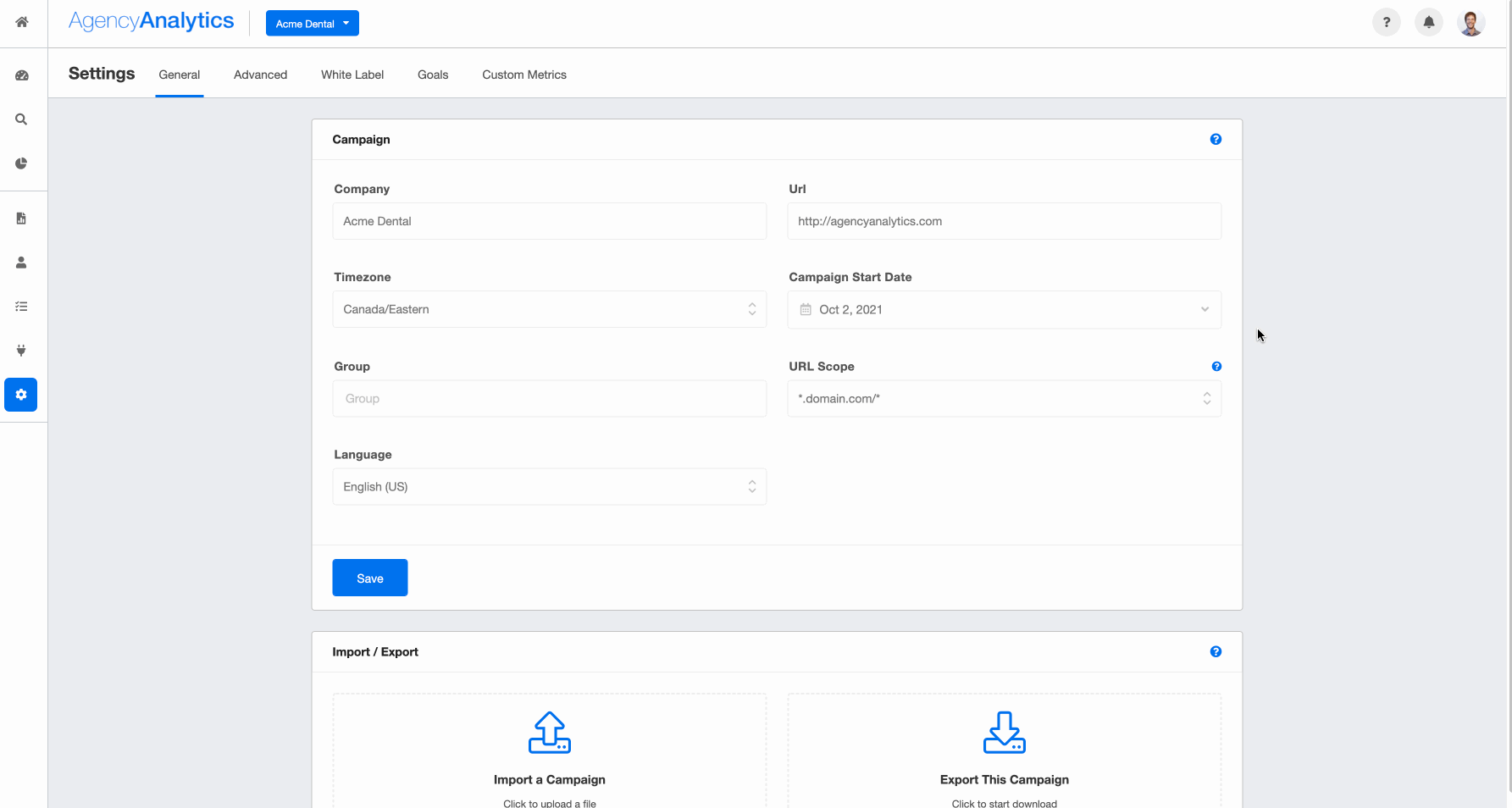
Next, fill out the Name, Interval, and Description.
The Metric area is where all the fun happens. Pick from the list of integrations, choose the metric you want to set a goal around, and then select the operator (such as less than, equal to, or greater than).
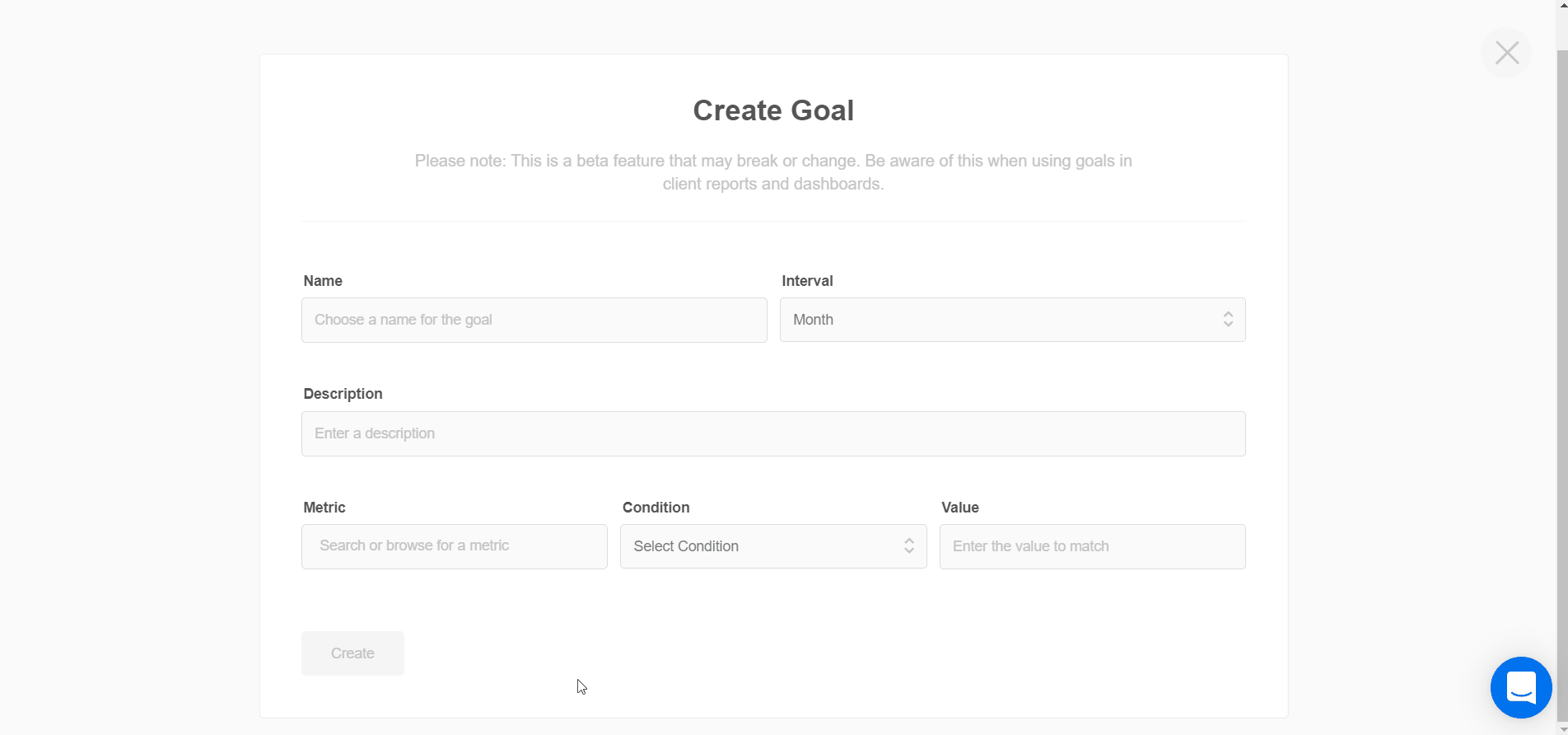
Voila - your Goal is now created and ready to use in your dashboards and reports!
Use these goals to track advertising conversions and phone calls or even pace the PPC budget for your clients' campaigns!
Adding Goals To Dashboards and Custom Reports
Adding a goals widget to your client’s dashboard or report only takes a few moments. Simply open the dashboard (or create a new one) and then use the drag-and-drop report editor to add the goals you just made.
AgencyAnalytics has made communicating the results of campaigns to our clients exponentially easier! We love being able to customize each report and dashboard to our client's specific goals. Since we offer custom marketing solutions, we need a reporting tool that can report on those easily! AgencyAnalytics has proven to be an excellent asset for our company.
Christina Cypher, Director of Marketing, Click Control Marketing
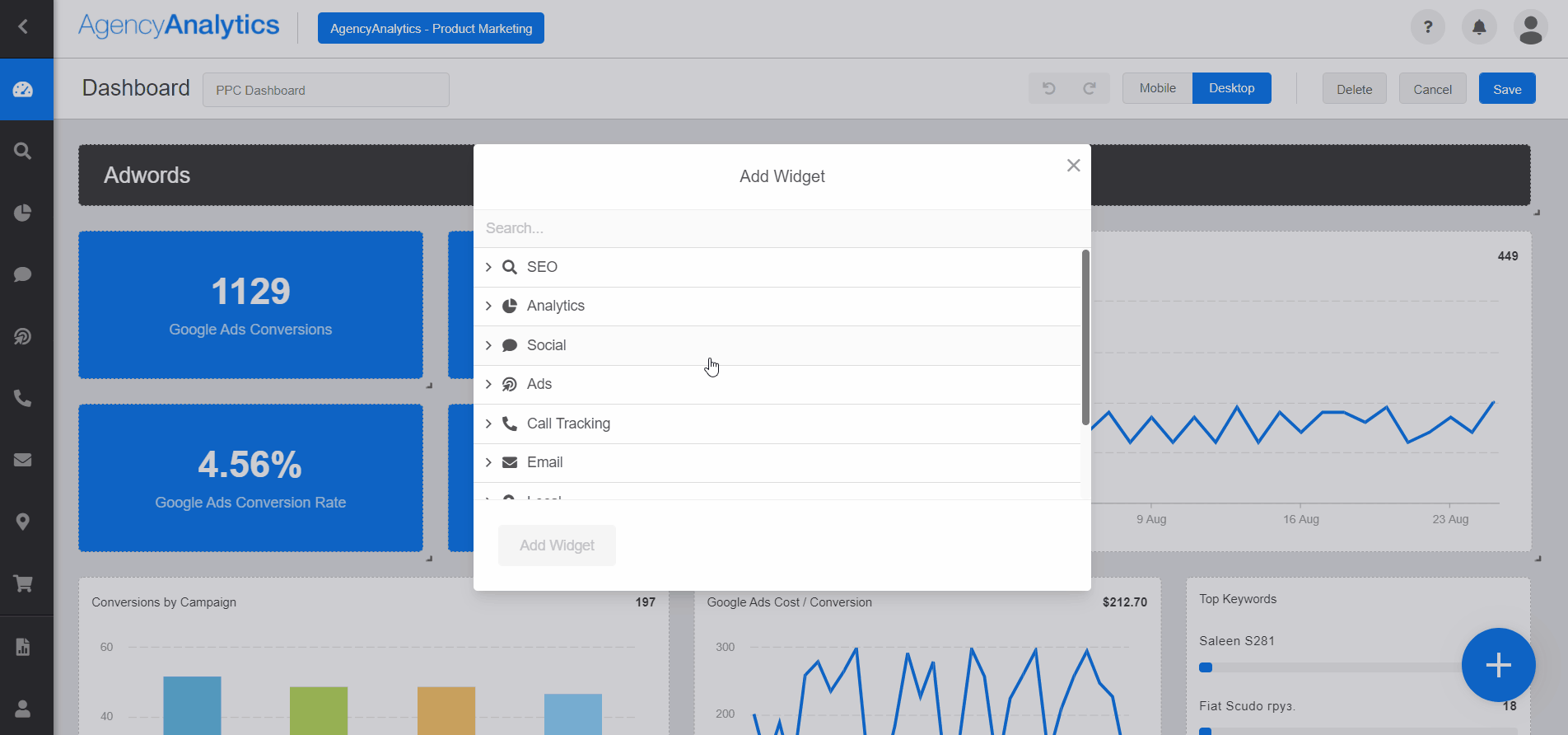
Your goals widget then appears, either displaying a red or green bar - depending on whether you're on or off track!
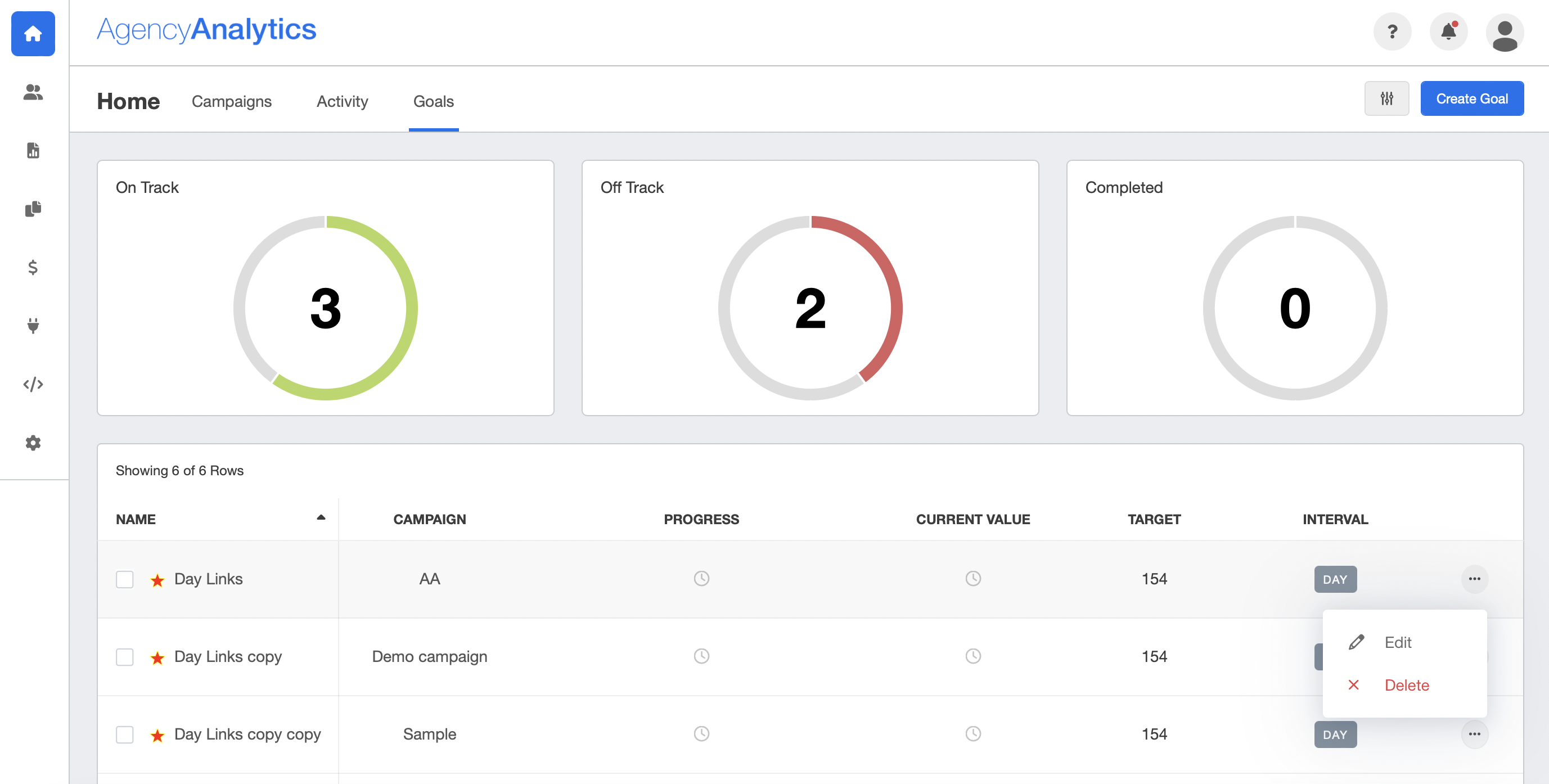
Interpreting and Presenting the Goals Report
The final step in goal-based reporting involves insightful interpretation and presentation of the report. The task here is to analyze the data and present it to the client in a simple, straightforward manner. The emphasis should be on what the campaigns have achieved concerning the client's goals. The aim is to tell a focused story of progress.
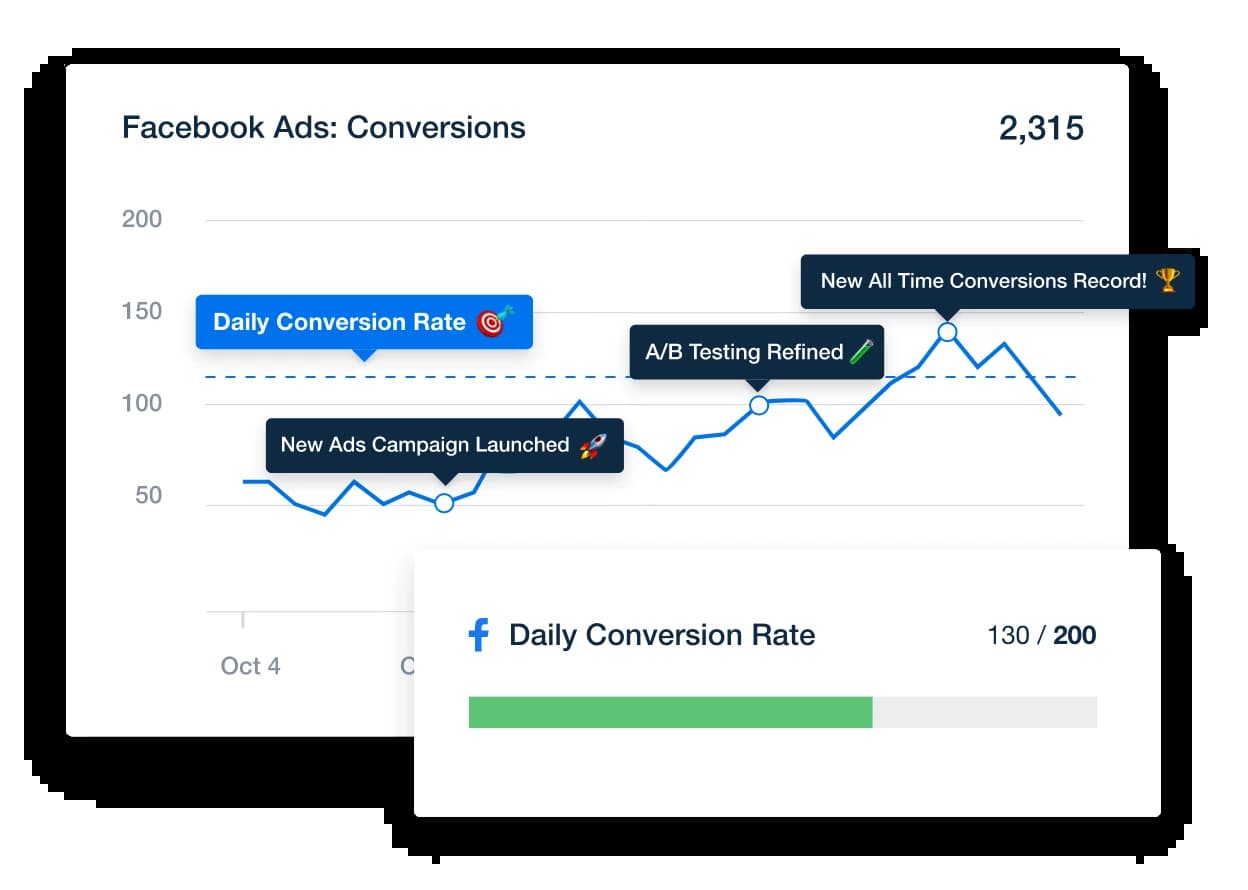
Creating annotations attached to the supporting metrics is a great way to turn raw data into compelling stories.
Scheduling Automated Goal Reports to Improve Client Relationships
Automated goal reports provide a practical solution for marketing agencies. These reports, which can be dispatched weekly, bi-weekly, monthly, or quarterly, save time by removing the need for manual preparation.

The automation allows agencies to focus more on strategy and innovation, while clients receive timely updates, enhancing the relationship and trust. It's a straightforward setup that benefits all parties involved.
In a nutshell, goal-based reporting identifies client goals, chooses relevant metrics, creates focused reports, and effectively presents the achieved results. Like any skill, mastery comes with practice.
Pitfalls to Avoid in Goal-Based Reporting
As beneficial as goal-based reporting can be, it's not a walk in the park. It requires precision, understanding, and a clear strategy. However, like most paths, it has its own set of pitfalls. Recognizing and avoiding these pitfalls is crucial for successful reporting. Let's delve into some of the common ones.
#1 - Making Mistakes When Identifying Goals
Identifying goals is the first step in goal-based reporting, and mistakes at this early stage can derail the entire process. One common mistake is setting vague goals. For example, if the sales team sets a goal to "increase sales," it leaves room for ambiguity. How much of an increase are they aiming for? In what timeframe do they want to achieve this increase? Clarity and specificity are essential to avoid such issues.
#2 - Making Sure that Goals Are Clear and Relevant
Clear, well-defined goals are the backbone of any successful goal-based report. Without them, it's impossible to determine if the client is progressing toward achieving their desired outcomes. Goals should be both clear and relevant. For example, if a client is a retail clothing store, an appropriate goal might be to "increase online sales by 20% over the next quarter." Such a goal provides a clear context, making it easier to track and understand whether the marketing efforts are performing as expected.
#3 - Avoiding Oversimplification
While keeping reports straightforward and understandable is crucial, there's a fine line between simplicity and oversimplification. Oversimplifying can strip out the necessary details that provide context for understanding whether or not you're meeting your client's goals. For example, merely stating that website traffic has increased without detailing which specific campaigns contributed to that increase might result in the client needing to understand the complete picture of their marketing performance.
Avoiding these pitfalls in goal-based reporting can lead to better, more insightful reports that provide clear and actionable information to clients. By being mindful of these challenges, marketing agencies can create reports that illustrate their value and help their clients achieve their desired outcomes.

Create a Digital Marketing dashboard in minutes using a pre-built template!
Summary and Key Takeaways
Goal-based reporting stands as a beacon in the world of digital marketing, providing a transparent, focused approach to tracking and measuring the impact of marketing efforts.
It's important to remember that creating individual goal reports is an art that requires a careful understanding of the client's goals, picking the right metrics that align with these goals, and using analytics tools to track progress effectively. Furthermore, this isn't a one-person show. The whole team must be involved to ensure a cohesive, well-rounded report.
Remember, the ultimate aim of goal-based reporting isn't just about presenting data—it's about showcasing progress and success in an understandable and meaningful way to the client. When executed correctly, it's a powerful tool for demonstrating the value a marketing agency brings to its clients.
If we aren’t growing the business, we cease to be relevant in the market. We don't have contracts, so we must ensure our results are dropping to the bottom line. AgencyAnalytics enables us to deliver these KPIs with accuracy, clarity, not to mention beautiful UI & UX, and our clients love it.
Bodie Czeladka, Creative & Managing Director, Dilate Digital
By using the insights and advice in this article, marketing agencies take their reporting to the next level, providing clients with valuable insights into their progress and successes. Now, that's reporting done right!

Written by
Melody Sinclair-Brooks brings nearly a decade of experience in marketing in the tech industry. Specializing in B2B messaging for startups and SaaS, she crafts campaigns that cut through the noise, leveraging customer insights and multichannel strategies for tangible growth.
Read more posts by Melody Sinclair-BrooksSee how 7,000+ marketing agencies help clients win
Free 14-day trial. No credit card required.



